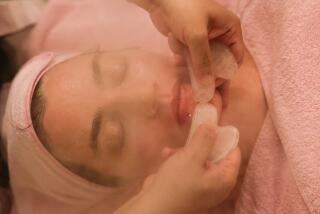A Peek Behind the Masque : Can Funny-Looking Facial Treatments Put Zing Into a Lackluster Complexion?
- Share via
For generations, women have applied facial masques made from such varied ingredients as avocados, honey, mud, even solutions of salt water and volcanic ash. The intention: Wash off the goo to uncover fresh-faced beauty. Today, masques used in salons and sold at cosmetics counters can also contain aloe, collagen and chemicals such as salicylic acid. The question is, are any of them effective?
Most major cosmetics lines include at least two masques: a cream-based formula designed to moisturize dry skin, and another--usually made with clay--designed to soak up excess oil from acne-prone or oily skin. Various proponents say that masques cleanse deeply, make pores appear smaller, smooth fine wrinkles, firm the skin, pep up a tired or sallow complexion, stimulate circulation and exfoliate the most superficial layer of the skin. Other skin-care specialists disagree.
Clay-based masques draw out impurities and can help loosen blackheads. Adrien Arpel, who offers a variety of masques sold at the Broadway and other stores, maintains that “clay masques absorb oil and pollutants, but they tighten pores. If the skin isn’t clean, the constriction may seal in the dirt.”
Ole Henriksen, whose Sunset Boulevard salon has polished the complexions of Liza Minnelli and Debra Winger, offers a more precise description of the function of masques. “It’s a fallacy to say that masques cleanse,” he says. “Cleansing is an entirely different process. The purpose of a masque is to temporarily firm the skin and make the pores look more refined.”
Many women purchase masques with the hope that they will remove wrinkles. “The masque is the most important step in smoothing out lines, but they won’t erase them,” says Beverly Hills-based skin-care expert Aida Grey.
Some dermatologists object to claims that masques reduce the size of pores. “The pores have no mechanism to close,” says Dr. Margaret Olsen, assistant clinical professor of dermatology at UCLA School of Medicine. What does happen, she explains, is that masques gently irritate the skin, “causing it to puff up, which in turn makes the pores look smaller.” The same swelling can cause some lines to seem less noticeable, she adds. Despite the slight irritation, Olsen says, masques generally are not harmful.
Many women also turn to masques for help when their complexions look tired and dull. Some say the effect on their skin is similar to the glow they enjoy after working out. Grey says masques do indeed have something in common with workouts. “A masque is the only exercise the skin gets,” she says, adding that the treatment stimulates circulation, which oxygenates the skin. “The ingredients can cause a tingle, and it makes people feel like they are getting something good out of the masque,” Olsen says, but she warns that masques with irritating ingredients should be avoided by women who have blotchy skin. “The skin may get redder and stay that way for days,” she says.
But many dermatologists say that complexions in need of exfoliating will profit from masques. They gently lift and slough off dead skin cells, according to Dr. Jonathan Zizmor, former chief of dermatology at St. Vincent’s Hospital in New York City. He calls the process “epiabrasion,” a very mild abrasion of the top layer of the skin.
San Francisco-based skin-care specialist Zia Wesley-Hosford, author of “Face Value--Skin Care for Women Over 35,” is among the experts who urge caution when using clay masques. In absorbing excess oil, she says, they can rob the skin of moisture. She says that no clay masque should be left on more than 15 minutes. “Clay absorbs 200 times its weight in water, so it can be very dehydrating,” she says. Vera Brown, of Vera’s Natural Beauty Retreat in Tarzana, suggests spraying on a facial mist before and after applying a masque to keep the skin soft and moist.
Brown adds that women with dry skin should never use a masque that dries to a hard surface, which is how many clay-based formulas work. For those clients, Brown recommends a moisture-rich, clay-free product. Henriksen, on the other hand, maintains that some clay-based masques are appropriate even for dry skin. “They neutralize the pH balance of the skin, making the skin taut, not dry. There’s a big difference,” he says. For very dry skin, “applying oil under the masque is beneficial. The oil will be sealed into the upper layers of the skin.”
Henriksen points out that a masque can help make the skin an ideal canvas for makeup. He says that unlike many complexions, the apres -masque face won’t absorb foundations and blushers. “Due to a lack of either moisture or nutrients, your skin (normally) ‘eats’ your makeup,” he says. “If the skin is provided with fats, proteins, vitamins, minerals and enzymes in a masque form before makeup, the skin will have no need to absorb the cosmetics.”
Masques may not obliterate wrinkles or turn a blemished face into a flawlessly smooth one, but they do offer tangible--if short-lived--benefits. As Henriksen says, a masque is a “temporary pick-me-up for the skin. It makes you feel good, and it makes your skin look good for several hours.”






